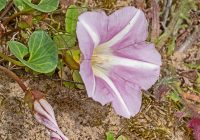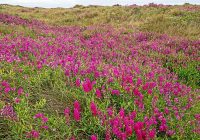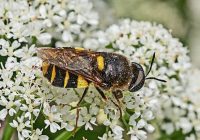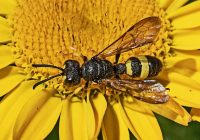Dr Phil Smith’s Wildlife Notes
June 2022
According to the Met. Office, June continued the run of warm dry months this year, rain in the northwest being only 50-75% of average. In Formby, measureable rain in small quantity fell on only nine days, mainly near the beginning and end of the month. This was reflected in a rapid fall in the dune water-table, the level in the Devil’s Hole, Ravenmeols, dropping by 15cm, leaving the slacks almost entirely dry. This time last year there was extensive surface water. I saw no evidence of Natterjack Toad breeding in the Devil’s Hole and it looks as though it was another poor year coastwide.
On the plus side, many of the special plants of the dunes have flowered well, especially the orchids. Trevor Davenport and I counted 112 Bee Orchids in a relatively small area of Ainsdale Sandhills LNR on 6th. The younger section of Green Beach north of Ainsdale-on-Sea provided a dazzling display of marsh-orchids, especially the Early Marsh-orchid, most of which are the brick-red coastal form coccinea, officially listed as ‘nationally scarce’ and ‘near threatened’ in England. It is also endemic to Britain and Ireland, not occurring anywhere else. Thousands of flower-spikes vied for attention with the larger magenta blooms of Southern Marsh-orchids. Regular visits to monitor vegetation changes on these rapidly evolving Green Beaches led to a much less spectacular ‘new’ plant: Slender Spike-rush, an often overlooked species with a mainly coastal distribution, concentrated in the north and west. More visually impressive were enormous golden drifts of Kidney Vetch. John Dempsey emailed to say that he had found a new colony of Sea Bindweed on the frontal dunes opposite Toad Hall at Ainsdale. Red-listed ‘vulnerable’ in England, this is one of our special plants, so I dashed over to see it. The big pink-and-white flowers and fleshy, kidney-shaped leaves covered an area of about 24x17m, making it the largest known colony on the coast. A great find! I also checked out the adjacent meadow where Patricia Lockwood and I found Rough Clover in 2012 at its only locality in the vice-county. It was still there, flowering in two small depressions despite the drought. Ironically, this site is threatened by a carpark development as part of the Ainsdale Gateway project. My clover hunt also led me to the sandy verges of Thornbeck Avenue, Hightown, to look for the Clustered Clover, discovered in 2013. I quickly found two patches with characteristic purplish flower-heads. Like the Rough Clover, this tiny annual has been badly affected by repeated spring droughts. Dry conditions don’t seem to impact the Broad-leaved Everlasting-pea, which has exploded this year on the frontal dunes north of Ainsdale. This invasive non-native looks pretty but has the potential to become a major problem.
In mid to late June, a trip to Crosby Coastal Park is always on my ‘to do’ list. Walking south from Crosby Baths, the abundance of Sea Holly on the dune ridge is astounding, as are the numbers of Common Broomrape flower-spikes, a plant that is parasitic on the Sea Holly. Steve Cross tells me he estimated 1900 spikes. He also counted about 2200 plants of Isle of Man Cabbage, probably the largest colony in the country and therefore in the world, of this British endemic. Stately Evening-primroses were just coming into flower. This is the best place on the Sefton Coast for this group, at least six kinds being found here. My favourite is the ‘nationally scarce’ hybrid, Oenothera x britannica, which has bright red buds and stems. Walking on, I came to the ‘nationally rare’ Dune Wormwood which Mike Wilcox and I found it here in 2004. It may be the only surviving site in Britain. I was delighted to see that it is doing really well, nine patches showing vigorous new growth. Benefitting from a reduced mowing regime, a section of the park grasslands is a dazzling vista of wildflowers, within which I estimated 300 Southern Marsh-orchids, six Common Spotted-orchids and 20 of the big hybrid between the two, Dactylorhiza x grandis. I made three visits to the Birkdale frontals and the adjacent Green Beach with a Liverpool University student who is studying the distribution of Baltic Rush, another of our special plants. The nearest locality for it is 200 miles away in Scotland. We found some new patches but several have been lost to rampant scrub development. While on the Green Beach, we heard Natterjacks calling from a flooded channel, though we couldn’t find them. The channel also held a large patch of Slender Spike-rush,while nearby were two plants of pink-flowered Thrift.
There is general agreement that, so far, this summer has been poor for insects. In June, numbers of most groups were well down, probably because of the drought, though there were some exceptions. Thus in contrast to most hoverflies, the Pied Plumehorn was abundant. I counted 18 on one visit to Alt Bridge. The larvae of this large and striking insect scavenge in the nests of social wasps. A patch of flowering umbellifers at Sands Lake, Ainsdale, produced one of the largest British soldierflies, the Banded General,a southern species that is moving north and was new to me.Pete Kinsella had one in the same place on the same date in 2020. The same patch had a Yellow-legged Beegrabber, a couple of solitary wasps and the uncommon Mini-tiger hoverfly. A visit to a friend’s ‘wildlife friendly’ garden in Southport showed what can be achieved by planting flowers selected for pollen and nectar, avoiding pesticides and providing habitats, such as a pond and ‘bee hotels’. Amongst a wealth of insects was a spectacular Ornate-tailed Digger Wasp, only the fourth record in the region of this mainly southern species. Finally, on the last day of the month, a visit to a sheltered glade between trees at Ravenmeols was rewarded with 11 Ringlet butterflies and a variety of other insects including two colour-forms of the Bumblebee Plumehorn, a hoverfly that mimics bumblebees.






